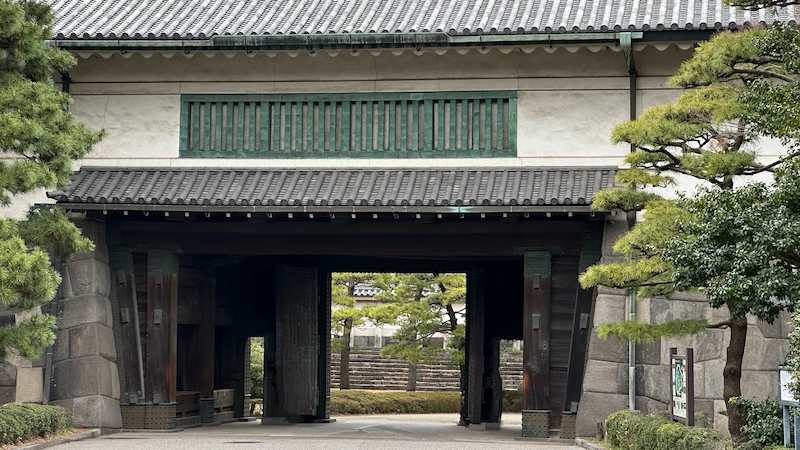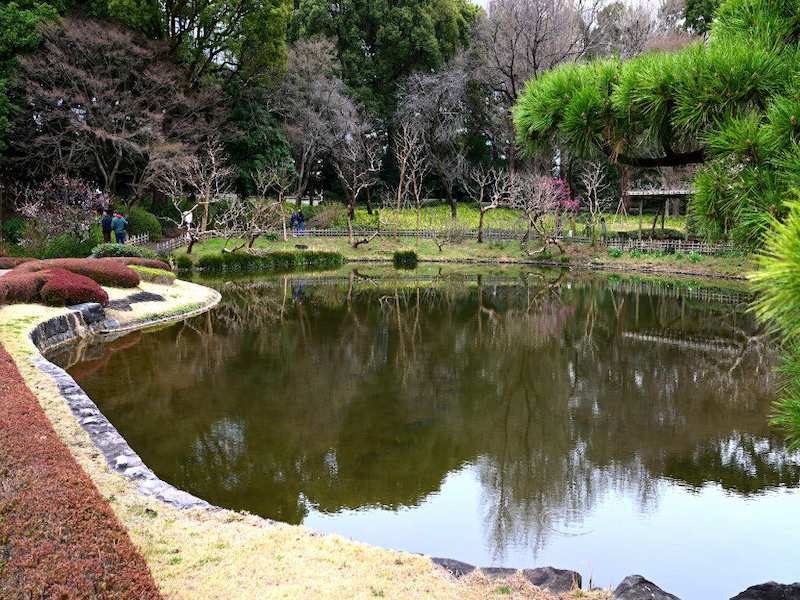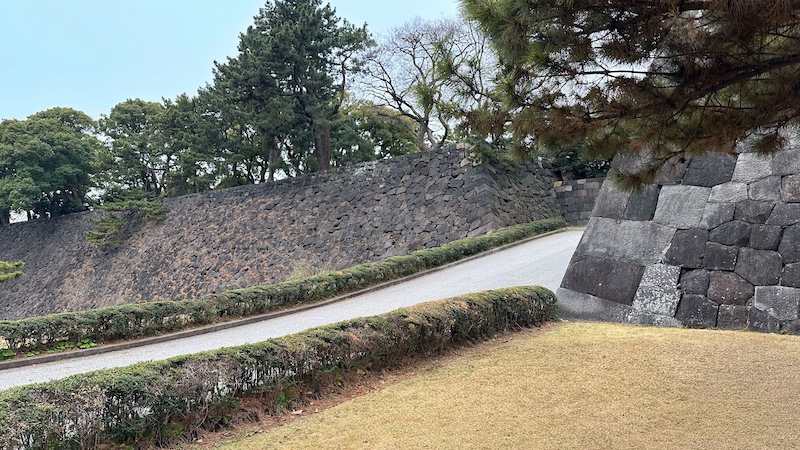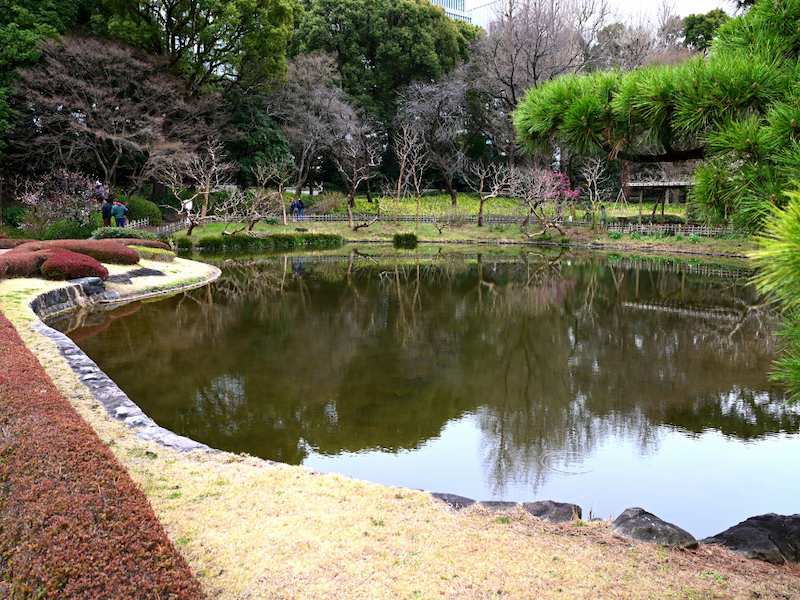After passing through the Honmaru area and moving slightly away from the core of Edo Castle, you will find the Ninomaru area, which once served as the living quarters of the Tokugawa shogunate. Closely connected to the Honmaru, yet offering a more serene and refined atmosphere, this area is home to historical sites that vividly retain the essence of the Edo period. Among them are the Ninomaru Garden, a favorite retreat of successive shoguns, the Hirakawa Gate, a key defensive and transport hub of Edo Castle, and Shiomizaka, a historic slope connecting the castle’s inner and outer domains. Walking the same paths once traversed by shoguns and feudal lords, you can immerse yourself in the daily life of Edo. In this article, we will explore the fascinating Ninomaru area in detail.
Ninomaru Area
Hirakawa Bridge
⭐ Recommended Rating
Historical :☆☆
Visual value:☆☆
Experiential:☆☆☆

Hirakawa Bridge (Hirakawabashi) is a wooden bridge located in the northeastern part of the East Gardens of the Imperial Palace, spanning the inner moat of Edo Castle. Originally built in 1614 (Keicho 19), it has undergone multiple renovations, with the current structure completed on March 31, 1988 (Showa 63). The bridge is made of Taiwanese cypress, with stone piers and abutments, and iron girders reinforcing its framework. Measuring 29.7 meters in length and 7.82 meters in width, it forms a gentle arch reminiscent of a taiko bridge.
Take a 360° Look Around
| Item | Content |
|---|---|
| Year Built | 1614 (Keichō 19) |
| Builder | Unknown |
| Structure/Features | Wooden arch bridge; the current structure rebuilt in 1988 using Taiwanese cypress with stone piers and iron beams |
| Renovation/Restoration | Rebuilt in 1988 (Shōwa 63) in its present form |
| Current Status | Still existing (1988 reconstruction) |
| Destruction/Damage | Unknown |
| Cultural Property Designation | Unknown |
| Remarks | – |
🗺 Address: Hitotsubashi 1-chome, Chiyoda-ku, Tokyo
🚶 Access:
Approximately 7 minutes walk (approximately 500 meters) from Kita-Hachimichi Gate
⏳ Suggested Visit Duration:
- Quick visit: About 5 minutes
- In-depth exploration: About 15 minutes
📍 Highlights:
- Architectural Beauty: The bridge’s wooden structure gracefully arches, showcasing the elegance of traditional Japanese bridge design.
- Scenic Views: From the bridge, you can enjoy lush greenery and the tranquil inner moat.
- Seasonal Attractions: In spring, cherry blossoms bloom around the bridge, creating a picturesque landscape.
📌 Trivia:
- Unexpected Historical Detail: The giboshi (ornamental finials) on the bridge railing originally adorned Nijubashi Bridge. They were repurposed in 1887 (Meiji 20) when that bridge was rebuilt. The ten giboshi date back to the Edo period, inscribed with the years 1614 (Keicho 19) and 1624 (Kanei 1).
- A Hidden Historical Spot: Hirakawa Bridge is the last remaining wooden bridge over the Imperial Palace’s inner moat, making it a cherished landmark.
Hirakawa Gate
⭐ Recommended Rating
Historical :☆☆
Visual value:☆☆
Experiential:☆☆☆

Hirakawa Gate (Hirakawamon) is one of the inner gates of Edo Castle, serving as an exit from the Sannomaru area to the outer domain. It was used primarily by court ladies and the three Tokugawa branch families (Tayasu, Hitotsubashi, and Shimizu), earning it the nickname “Otsubone Go-mon” (Ladies’ Gate). Architecturally, it is the only masugata-style gate featuring two korai gates.
Take a 360° Look Around
| Item | Content |
|---|---|
| Year Built | Early Edo period (exact year unknown) |
| Builder | Unknown |
| Structure/Features | Masugata-style gate with two korai gates; unique among Edo Castle gates |
| Renovation/Restoration | Restored in 1962 |
| Current Status | Original structure remains |
| Destruction/Damage | None documented |
| Cultural Property Designation | None |
| Remarks | – |
🗺 Address: 1-1 Chiyoda, Chiyoda-ku, Tokyo
🚶 Access:
Approximately 1 minute walk (approximately 50m) from Hirakawa Bridge
⏳ Suggested Visit Duration:
- Quick visit: About 5 minutes
- In-depth exploration: About 15 minutes
📍 Highlights:
- Unique Gate Design: Features two korai gates and a square layout, showcasing Edo-period castle architecture.
- Obikuruwa (Bailey Area): A long, narrow section extending toward Takebashi Gate.
- Hirakawa Bridge: The wooden bridge in front of the gate, originally built in 1614 and reconstructed in 1988.
📌 Trivia:
- Unexpected Historical Detail: The area around Hirakawa Gate was once home to Kami-Hirakawa and Shimo-Hirakawa villages, which inspired the gate’s name.
- A Hidden Historical Spot: Inside the gate lies another entrance called “Fujomon” (Impure Gate), used to transport the deceased and criminals out of the castle.
- Famous Connections: The gate served as an entry point for the Tokugawa Gosanke (three main Tokugawa branch families) when visiting the castle.
Suwa-no-Chaya
⭐ Recommended Rating
Historical :☆
Visual value:☆☆☆
Experiential:☆

Suwa-no-Chaya is a refined tea house situated within the Ninomaru Garden of the East Gardens of the Imperial Palace. Originally built during the reign of the 11th shogun, Tokugawa Ienari, it was relocated from Fukiage Garden to its current site in 1968 (Showa 43). The present structure dates back to 1912 (Meiji 45) and harmonizes beautifully with the surrounding landscape.
Take a 360° Look Around
| Item | Content |
|---|---|
| Year Built | Originally built during the reign of Tokugawa Ienari; current structure from 1912 (Meiji 45) |
| Builder | Unknown |
| Structure/Features | Traditional tea house architecture harmonizing with the surrounding garden |
| Renovation/Restoration | Relocated to current location in 1968 (Shōwa 43) |
| Current Status | Existing structure from 1912 |
| Destruction/Damage | Original structure lost to fire; current structure is a reconstruction |
| Cultural Property Designation | None |
| Remarks | – |
🗺 Address: 1-1 Chiyoda, Chiyoda-ku, Tokyo
🚶 Access:
Approximately 6 minutes walk from Hirakawa Gate (approximately 400m)
⏳ Suggested Visit Duration:
- Quick visit: About 20 minutes
- In-depth exploration: About 40 minutes
📍 Highlights:
- Traditional Tea House Architecture: Features classic Edo-period tea house design.
- Harmony with Nature: Blends seamlessly with the surrounding Ninomaru Garden.
- Seasonal Beauty: Cherry blossoms in spring, lush greenery in summer, autumn foliage, and snowy winter landscapes offer ever-changing scenery.
📌 Trivia:
- Unexpected Historical Detail: Originally located in Fukiage Garden, it was moved to Ninomaru Garden in 1968.
- A Hidden Historical Spot: The tea house is not open to the public, but its elegant exterior can be admired from outside.
- Famous Connections: Edo-period feudal lords frequently used such tea houses for cultural gatherings.
Ninomaru Garden
⭐ Recommended Rating
Historical :☆☆
Visual value:☆☆☆
Experiential:☆☆

Ninomaru Garden is a pond-centered stroll garden located within the East Gardens of the Imperial Palace. Originally designed by the renowned garden master Kobori Enshu during the early Edo period, it was later renovated under the orders of the third shogun, Tokugawa Iemitsu. Over time, the garden fell into disrepair but was restored in the Showa era based on historical blueprints from the time of the ninth shogun, Tokugawa Ieshige.
In 2018, Emperor Emeritus Akihito and Empress Emerita Michiko released Hirenaga Nishikigoi (long-finned ornamental carp) into the garden’s pond. This unique breed was developed through crossbreeding between Japanese koi and Indonesian long-finned carp, inspired by the then-Crown Prince’s interest in the species in 1977. Visitors today can admire these graceful fish swimming in the pond.
Take a 360° Look Around
| Item | Content |
|---|---|
| Year Built | Originally designed in 1636; restored in 1968 |
| Builder | Designed by Kobori Enshū |
| Structure/Features | Pond-centered stroll garden with symbolic islands and seasonal flora |
| Renovation/Restoration | Restored in 1968 based on historical blueprints |
| Current Status | Restored garden open to the public |
| Destruction/Damage | Original garden destroyed by fire in 1867 |
| Cultural Property Designation | None |
| Remarks | – |
🗺 Address: 1-1 Chiyoda, Chiyoda-ku, Tokyo
🚶 Access:
About 10 minutes walk from Suwa no Chaya (about 0.8km)
⏳ Suggested Visit Duration:
- Quick visit: About 15 minutes
- In-depth exploration: About 30 minutes
📍 Highlights:
- Pond-Centered Stroll Garden: Designed in the Shoin-style, the garden features a central pond with Horai Island, flanked by symbolic crane and turtle islets.
- Seasonal Flowers: The garden is adorned with cherry blossoms in spring, irises in early summer, and vibrant autumn foliage, creating a stunning seasonal landscape.
- Historical Structures: Traditional stone lanterns and tea houses scattered throughout the garden offer glimpses into Edo-period aesthetics.
📌 Trivia:
- Unexpected Historical Detail: The Ninomaru Garden fell into neglect after the Meiji era but was restored in 1968 (Showa 43), bringing it back to its former glory.
- A Hidden Historical Spot: The pond is home to koi fish, including the special Hirenaga Nishikigoi, which add to the garden’s charm.
- Famous Connections: The garden was designed by Kobori Enshu, a master of landscape architecture and tea ceremony, whose works are still admired across Japan.
Shiomizaka
⭐ Recommended Rating
Historical :☆☆
Visual value:☆☆☆
Experiential:☆☆

Shiomizaka (Shiomizaka Slope) is a historically significant slope within the East Gardens of the Imperial Palace, connecting the Honmaru and Ninomaru areas. During the Edo period, the “Shiomizaka Gate” stood at this location, and it is said that the name “Shiomizaka” (literally “Tide-Viewing Slope”) originated from the fact that one could see the Hibiya Inlet from this vantage point. Adjacent to the slope is Shiratori Moat, which showcases the castle’s formidable defensive architecture.
Recent excavations have revealed remnants of the 1637 (Kanei 14) Tosho-gu Shrine between Shiomizaka and Umezaka during stone wall repairs.
| Item | Content |
|---|---|
| Year Built | Exact year unknown; existed during the Edo period |
| Builder | Unknown |
| Structure/Features | Historical slope connecting Honmaru and Ninomaru areas; features contrasting stone wall techniques |
| Renovation/Restoration | Restoration work on the stone walls was carried out from 2002 to 2005. |
| Current Status | Existing slope with restored stone walls |
| Destruction/Damage | None documented |
| Cultural Property Designation | None |
| Remarks | – |
🗺 Address: 1 Chiyoda, Chiyoda-ku, Tokyo
🚶 Access:
About 10 minutes walk from Ninomaru Garden (about 0.8km)
⏳ Suggested Visit Duration:
- Quick visit: About 5 minutes
- In-depth exploration: About 15 minutes
📍 Highlights:
- Contrasting Stone Wall Techniques: The left side (Shiratori Moat side) retains the original “Uchikomi-hagi” stone masonry from the castle’s construction, while the right side features “Kirikomi-hagi,” a more refined method used in later restorations. Visitors can compare these techniques up close.
- Tosho-gu Shrine Remnants: Discovered during stone wall repairs, these remains offer insight into the architectural and religious history of Edo-period Japan.
- Seasonal Beauty: In spring, the area is adorned with plum and cherry blossoms, while autumn brings brilliant foliage, making it a picturesque spot year-round.
📌 Trivia:
- Unexpected Historical Detail: During the Great Meireki Fire of 1657, it is said that gold and silver treasures were thrown into Shiratori Moat to protect them from the flames.
- A Hidden Historical Spot: Unlike other moats, Shiratori Moat is a self-contained body of water with no inflowing streams, maintaining a stable water level through underground springs.
- Famous Connections: As part of Edo Castle, Shiomizaka was traversed by numerous historical figures, including successive Tokugawa shoguns and their retainers.




comment